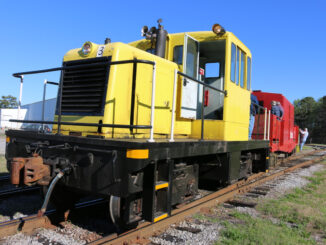MARIETTA – Turn back the clock 145 years.
It’s April 12, 1862, the one-year anniversary of the start of the Civil War, and the morning passenger train is pulling into town. Pulled by the locomotive General, the train comes to a halt and 20 men step on board. They’re headed to different stops to the north.
What no one on board the train knew is that the 20 men were Union spies. Led by James J. Andrews, the men planned to steal the train’s locomotive at the next stop and then destroy the Western & Atlantic Railroad, a vital link between Atlanta and Chattanooga, Tenn., in the heart of the Confederacy.
The Andrews Raid, also known as The Great Locomotive Chase, ultimately failed. But days later, the Southern Confederacy newspaper proclaimed it “the most extraordinary and astounding adventure of the war.” More than an “astounding adventure,” the raid was near genius.
Andrews devised not only a daring plan, but also a complicated one, involving his deceit and destruction coupled with the coordinated movement of Gen. Ormsby Mitchel and his troops. Had the weather been clear and the raid taken place on April 11, 1862, when the railroad was less congested, the Civil War would have no doubt played out differently.
Regardless, the raid raised the general awareness about the importance of railroads and also their vulnerability. Following the raid, the Confederacy guarded its lines closer and a year later stopped a second attempted raid against the Western and Atlantic Railroad.
Since the end of the Civil War, the raid was memorialized in film and books, but the best way to learn about the events of April 12, 1862, come through walking in the footsteps of the raiders themselves.
The route of the Andrews Raid can be easily retraced in the better part of a day. Historic markers, railroad depots and other raid-related places await the curious traveler. That includes the two stars of the raid: the General and the Texas, two of the locomotives used during the day.
The following is a list of some of the Andrews Raid-related sights worth visiting.
Marietta Museum of History
Today, the Kennesaw House is the starting point for anyone who wants to retrace the Andrews Raid. There’s a historic marker on the outside, but inside, the building is home to the Marietta Museum of History.
The museum offers a series of exhibits dedicated to the city’s history and a general look back at years past.
One room, the very room Andrews stayed in April 1862, is dedicated to the Civil War and the Great Locomotive Chase.
There’s considerable memorabilia, including photographs and artifacts, related not only to the Andrews Raid, but also to the war in general.
Southern Museum of Civil War and Locomotive History
While Andrews and the 19 raiders boarded the train in Marietta, the nearby city of Kennesaw is actually the starting point of the Great Locomotive Chase. The train stopped in the city – then known as Big Shanty – for breakfast.
During the layover, the raiders stole the locomotive from under the noses of thousands of Confederate soldiers stationed at nearby Camp MacDonald and began their trek north.
Today, the General is the centerpiece of The Southern Museum of Civil War and Locomotive History, a museum located in downtown Kennesaw less than 100 yards from where the raid began. Beyond its extensive raid-related collection, the museum is home to many war and railroad exhibits.
It’s also home to a display about Glover Machine Works, a local engine builder. The Glover exhibit gives museum goers a look at how steam locomotives were built and what a factory of that era would have looked like. Restored Glover locomotives are also on display.
Kingston: The raid’s turning point
Railroad travel was very different during the Civil War, and stops were frequent. Similarly, towns that are no longer vital railroad communities were hubs during the Civil War.
Such is the case with the Georgia town of Kingston.
In the mid 19th century, Kingston was a junction for the Western & Atlantic and the Rome railroads.
The raiders were making good time on their plot to destroy the Western & Atlantic, but other troop movements in the
Southeast led to more southbound trains on the line.
So, when the raiders reached the town of Kingston, they encountered an unexpected delay. The delay would turn out to also be a deadly one, as it gave a pursuing party time to close the gap.
While there is little that remains to show just how important this town was, the former track bed of the Rome Railroad and the foundation of the town’s railroad depot remain.
Tunnel Hill
Perhaps the most impressive sight along the route isn’t a museum. Rather, it’s the 1,477-foot tunnel through the Chetoogeta Mountain, which was completed by May 9, 1850, when the first train passed through it.
The tunnel has been out of use since 1928, when a larger passage through the mountain opened, but the old railroad right of way and tunnel remain today. Even though it is no longer in use, the old tunnel is an impressive sight.
Ringgold
About two miles north of Ringgold, the Great Locomotive Chase came to an end.
The old train depot that opened May 9, 1850, was the last building the raiders saw before their adventure came to an end.
The building was damaged on Nov. 27, 1863, during the Battle of Ringgold, but it was, however, repaired using limestone blocks.
Just north of town, at the exact location where the Andrews Raid ended (mile post 116.3), is a historic marker. The marker is located of Georgia Highway 151, also known locally as Ooltewah Ringgold Road.
The Cyclorama
Located in Grant Park in Atlanta, The Cyclorama is best known for its painted depiction of the Battle of Atlanta on July 22, 1864. The theater rotates in a 360-degree circle, allowing the audience to see the entire 42-foot-tall painting. There’s also narration on each part of the scene as the room rotates.
But while visitors are waiting to view that painting, they have the chance to see the locomotive Texas, the engine that ultimately caught up with the General to help end the chase.
Postscript
There are certainly more stops that could be made along the route of the Andrews Raid, such as the National Cemetery at Chattanooga where Andrews and seven of the raiders are buried in the shadows of a monument dedicated to the raid.
But the half-dozen locations listed here give willing travelers a nice overview of the raid and can be seen in a day or two, depending on how long is spent in each location.




